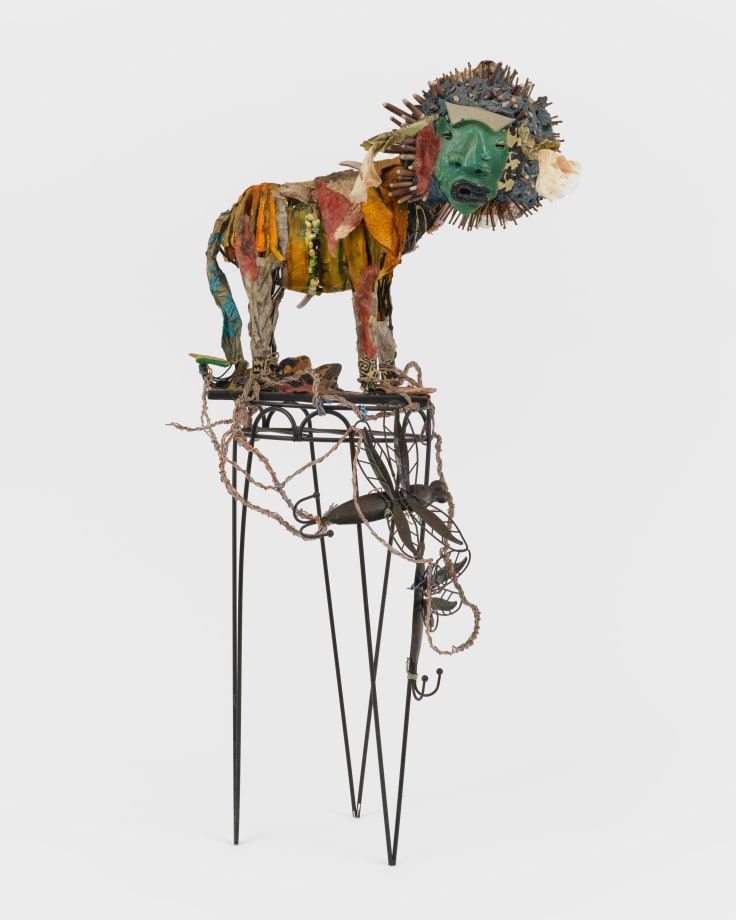Teresa Tolliver "Made in LA: Acts of Living": The Hammer Museum
Made in L.A. 2023: Acts of Living is the sixth iteration of the Hammer’s biennial exhibition highlighting the practices of artists working throughout the greater Los Angeles area. These practices embrace the value of craft, materiality, performance, and collectivity. The biennial situates art as an expanded field of culture that is entangled with everyday life; community networks; queer affect; and indigenous and diasporic histories.
Made in L.A. 2023: Acts of Living takes its title from a quote by the renowned Los Angeles artist Noah Purifoy, which is inscribed on a plaque at the Watts Towers: “One does not have to be a visual artist to utilize creative potential. Creativity can be an act of living, a way of life, and a formula for doing the right thing.” The history of Watts Towers—built by Simon Rodia over the course of 33 years and then preserved by the local South L.A. community, including Purifoy, to become a hub for arts education—embodies this ethos and offers a salient metaphor for this biennial. Made in L.A. 2023: Acts of Living is organized by Diana Nawi and Pablo José Ramírez, with Ashton Cooper, Luce Curatorial Fellow.
Teresa Tolliver is a practitioner of assemblage, utilizing ceramics, painting, and sculpture to create works structured within principles of reuse, place, and
the power of reconceptualization. Her work ranges in subject matter with particular attention to the figurative and is defined by a diversity of scales, from miniature to monumental, and materials, which include yarn, fabric, wire, cotton, tile, and other organic mediums. Tolliver moves within an African diasporic sculptural practice rooted in the strategy of assemblage that emerged in a post–Watts Rebellion Los Angeles wherein socio-geographies defined by race, class, and access imbued materials with political significance and the potential for radical rearticulations. Her assemblage practice also attends to a Black feminist epistemology, a way of knowing rooted in lived experience, an ethics of care, dialogue, and accountability. She considers her own biography and coming of age in South Central Los Angeles as a resource from which to create and as a site to pour that creativity back into. Tolliver’s object-based work and her work as an educator—she has taught for more than two decades in museums, schools, and nonprofit settings—exemplify her commitment to this ethos of world-building.
Tolliver’s doll works and Wild Things (2003–5) series exemplify the artist’s meticulous hand and commitment to assemblage as a transformative and geographically compelled practice. Begun in the 1980s, her doll series uses repurposed wire, yarn, cotton, iron, plastic, stuffed animals, and ceramics to create unwieldy figurative forms. The heads of these dolls might be swirls of black wire, defying gravity and solidity as hair and face forge in and out of the bent wire. Torsos and legs are carriages of recycled objects, a melody of textures and hues encased in a thread-bound cylinder. Eyes, noses, hands, and chests appear among Tolliver’s amalgamated forms, merging abstraction and figuration. These doll works exist in a centuries-old Black American tradition wherein repurposed fabrics and materials—often from one’s own geographic location—were used to create hand-made representational forms for Black children. Tolliver’s investment in imaging Black girlhood presents a complex and responsive structure, a type of iconography forged from the matter of Los Angeles.
The Wild Things series utilizes a repeated form—a mass-produced decorative lion—to create a world of assemblages that vary wildly in scale, color, materials, and arrangement. In one Wild Things sculpture, a lion becomes the armature of a human-faced, four-legged form draped in neon-painted fragments, wire, metal, straw, and fibers. The ceramic face is aesthetically sculpted in the tradition of West and Central African masquerade. In another, the lion armature is morphed into a complex chimera with a bear face, antlers, and a large mane of oranges, yellows, and reds. In the hundred or so assemblage sculptures, Tolliver creates a broad vocabulary, shifting scale and materiality through the addition of bases, decorative objects, and a host of handmade elements.
Assemblage as a discipline is a commitment to alchemy in both materials and theory, requiring the practitioner to take the form itself as something malleable. Tolliver’s expressive mastery is exhibited in her overall works, her pedagogy, and her ability to morph the mundane into an expansive visual iconography.
—Essence Harden
-
 Teresa Tolliver, Wild Thing, 2003-2005
Teresa Tolliver, Wild Thing, 2003-2005 -
 Teresa Tolliver, Wild Thing, 2003-2005
Teresa Tolliver, Wild Thing, 2003-2005 -
 Teresa Tolliver, Wild Thing, 2003-2005
Teresa Tolliver, Wild Thing, 2003-2005 -
 Teresa Tolliver, Wild Thing, 2003-2005
Teresa Tolliver, Wild Thing, 2003-2005 -
 Teresa Tolliver, Wild Thing, 2003-2005
Teresa Tolliver, Wild Thing, 2003-2005 -
 Teresa Tolliver, Wild Thing, 2003-2005
Teresa Tolliver, Wild Thing, 2003-2005 -
 Teresa Tolliver, Wild Thing, 2003-2005
Teresa Tolliver, Wild Thing, 2003-2005 -
 Teresa Tolliver, Wild Thing, 2003-2005
Teresa Tolliver, Wild Thing, 2003-2005 -
 Teresa Tolliver, Wild Thing, 2003-2005
Teresa Tolliver, Wild Thing, 2003-2005 -
 Teresa Tolliver, Wild Thing, 2003-2005
Teresa Tolliver, Wild Thing, 2003-2005 -
 Teresa Tolliver, Wild Thing, 2003-2005
Teresa Tolliver, Wild Thing, 2003-2005 -
 Teresa Tolliver, Wild Thing, 2003-2005
Teresa Tolliver, Wild Thing, 2003-2005 -
 Teresa Tolliver, Wild Thing, 2003-2005
Teresa Tolliver, Wild Thing, 2003-2005 -
 Teresa Tolliver, Wild Thing, 2003-2005
Teresa Tolliver, Wild Thing, 2003-2005 -
 Teresa Tolliver, Wild Thing, 2003-2005
Teresa Tolliver, Wild Thing, 2003-2005 -
 Teresa Tolliver, Wild Thing, 2003-2005
Teresa Tolliver, Wild Thing, 2003-2005 -
 Teresa Tolliver, Wild Thing, 2003-2005
Teresa Tolliver, Wild Thing, 2003-2005 -
 Teresa Tolliver, Wild Thing, 2003-2005
Teresa Tolliver, Wild Thing, 2003-2005 -
 Teresa Tolliver, Wild Thing, 2003-2005
Teresa Tolliver, Wild Thing, 2003-2005 -
 Teresa Tolliver, Wild Things, 2003-2005
Teresa Tolliver, Wild Things, 2003-2005






















